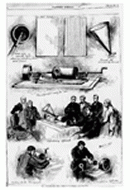Introduction



Thomas Alva Edison was born on February 11, 1847, in Milan, Ohio. Working with the telegraph in his late teens and early twenties started Edison on the road to invention. Early innovations, such as the automatic telegraph, the quadruplex, and the Edison Universal Stock Printer allowed Edison to focus his efforts on inventing. He eventually opened up his own laboratories in Newark, New Jersey and later West Orange, New Jersey. It was at these locations that Edison and his assistants developed such technologies as the Electric Pen, incandescent electric light bulb, the phonograph and the kinetograph, the first motion picture camera. He even built Pearl Street Central Power Station in New York City, which was the first electric power station.
Throughout this site, you will examine issues dealing with why Edison opened his laboratories in New Jersey, how his inventions changed society and were accepted by society, how the process of invention was revolutionized by Edison, and why we remember Edison the way that we do.
Growth of Industry in New Jersey
In this section you will research how New Jersey fit the criteria of a manufacturing location as described by Alexander Hamilton. You will also analyze maps and photographs in order to discern why Edison located his first laboratory in Newark, NJ.
Inventions of Edison
This section will introduce you to some of the inventions of Edison and their impact on society. You will analyze documents such as newspaper articles and photographs and do activities that will allow you to explore some alternative uses for Edison? discoveries.
Edison on Trial
This interactive lesson uses a fictional court transcript to examine the role of Edison and his associates in the invention process. You will analyze documents including firsthand accounts and photographs about the process of invention developed under Edison? leadership that is still evident in the Research and Development industry of today.